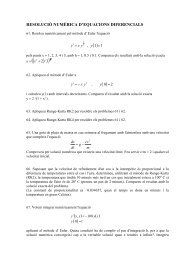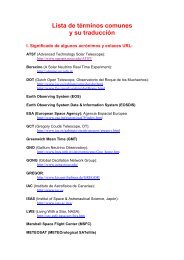Universitat de - Departament d'Astronomia i Meteorologia ...
Universitat de - Departament d'Astronomia i Meteorologia ...
Universitat de - Departament d'Astronomia i Meteorologia ...
Create successful ePaper yourself
Turn your PDF publications into a flip-book with our unique Google optimized e-Paper software.
3.4. SNR G016.8−01.1 103<br />
Normalized Intensity<br />
1,4<br />
1,2<br />
1,0<br />
0,8<br />
0,6<br />
0,4<br />
0,2<br />
0,0<br />
-0,2<br />
-0,4<br />
-0,6<br />
-100 -80 -60 -40 -20 0 20 40 60 80<br />
Velocity (km/s)<br />
Figure 3.3: H166α line observations of the H ii-region RCW 164. The solid line repre-<br />
sents a Gaussian fit to the data, with its maximum being at v = 16.5 ± 0.8 km s −1 .<br />
(J. A. Combi, private communication). The angular diameter of the remnant is<br />
∼ 30 ′ , and its distance remains unknown.<br />
3.4.1 A lower limit of the distance<br />
In or<strong>de</strong>r to <strong>de</strong>termine a lower limit of the distance to SNR G016.8−01.1, we car-<br />
ried out H166α recombination line (1424.734 MHz) observations of the foreground<br />
H ii-region on 2000 November 17. We used a 30-m radiotelescope at the Instituto<br />
Argentino <strong>de</strong> Radioastronomía (IAR), Villa Elisa. The receiver is a helium-cooled<br />
HEMT amplifier with a 1008-channel autocorrelator at the back end. The HPBW<br />
at a wavelength of 21 cm is 30 ′ and the temperature of the system on the cold sky<br />
during the observations was about 35 K. The H166α line was <strong>de</strong>tected at a veloc-<br />
ity of 16.5 ± 0.8 km s −1 (see Fig. 3.3) after 1.5 hours of integration time, with a<br />
signal-to-noise ratio of ∼ 4. At a location of l ≈ 16.8 ◦ , b ≈ −1.1 ◦ , standard galactic<br />
rotation mo<strong>de</strong>ls (Fich et al. 1989) indicate that the observed velocity corresponds<br />
to a distance d ∼ 1.8 kpc. Consequently, SNR G016.8−01.1 should be farther than<br />
∼ 2 kpc, as suggested by its relatively small angular size.






